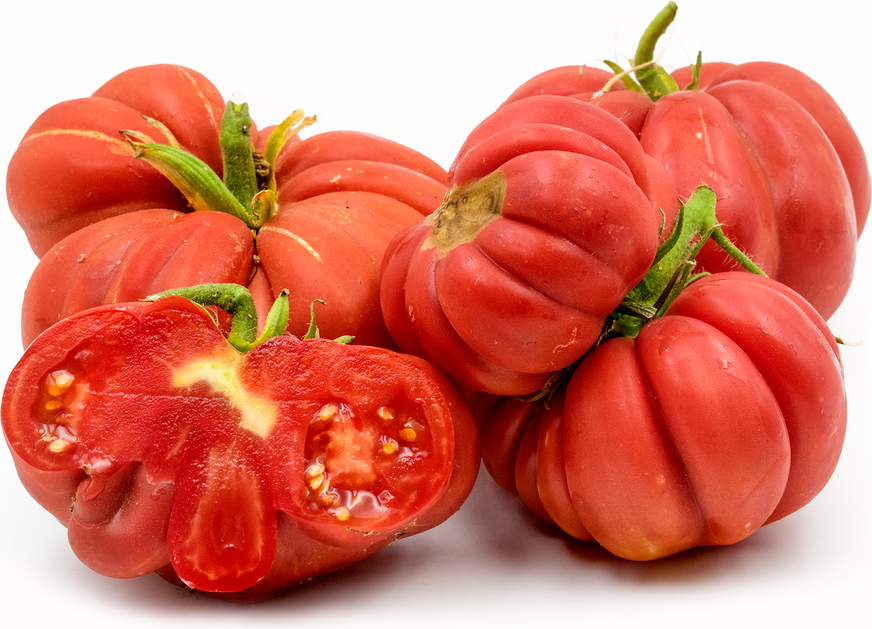


Mushroom Basket Heirloom Tomatoes
Estimated Inventory, lb : 0
Description/Taste
Mushroom Basket tomatoes are a large, heirloom variety known for their dramatic ribbed shape. They are heavier and larger than most tomato varieties, weighing around 8 to 16 ounces and measuring 7 to 11 centimeters across. They have a pumpkin-like shape with non-uniform, deep, defined pleats spaced throughout the tomato's perimeter and a light green stem. Their skin is bright red with occasional cream-colored speckles and a shiny, smooth texture. When cut in half, Mushroom Basket tomatoes have a flower-like shape. Their pinkish-red flesh is succulent yet firm and meaty, with very little gel and few seeds, giving them a high flesh-to-seed ratio. Mushroom Basket tomatoes have a sweet, mild, and smooth flavor.
Seasons/Availability
Mushroom Basket tomatoes are available from summer to mid-fall.
Current Facts
The botanical name for Mushroom Basket tomatoes is Lycopersicon lycopersicum and they are part of the Solanaceae, or nightshade, family along with all other tomatoes, chili peppers, eggplants, potatoes, and tobacco. Mushroom Basket tomatoes are mostly used for culinary purposes and grow on plants that can reach almost 2 meters high. They may also grow on trellises to support their heavy weight. Their name comes from their resemblance to the mushroom-collecting baskets traditionally used in Eastern Europe. Mushroom Basket tomatoes are native to Russia, a country that produces many other tomato varieties. Since their commercial release in the early 21st century, Mushroom Basket tomatoes are favored for their dense flesh and subtly sweet and acidic taste. The variety is considered multi-purpose and is incorporated into fresh or cooked culinary preparations.
Nutritional Value
Mushroom Basket tomatoes are high in vitamins C and K, which can help with body tissue growth, collagen production, iron absorption, immune system function, wound healing, bone health, bone density, and encouraging blood clotting to prevent excessive bleeding. Mushroom Basket tomatoes are a source of fiber, potassium, and folate. These nutrients are important for digestion, brain function, mental and emotional health, cell growth, muscle contractions, blood pressure reduction, and protection against osteoporosis, kidney stones, and stroke. Like all tomato varieties, they contain lycopene that can protect the overall health of the body, prevent free radical damage, and decrease inflammation.
Applications
Mushroom Basket tomatoes can be eaten fresh, roasted, dried, cooked, or canned. Their dense, meaty texture makes them ideal for recipes that call for sliced tomatoes. When sliced, they can be layered with mozzarella and basil for a caprese appetizer, used in sandwiches and burgers, or placed on top of a margarita pizza. Their large, hefty shape makes them convenient for stuffing with ingredients like bread crumbs, garlic, parsley, basil, thyme, cheese, and chiles and baking in the oven. Diced Mushroom Basket tomatoes may be incorporated into soups, salads, chili, rice bowls, stir-fry, omelets, pasta sauces, and tomato paste. They can be mixed into cocktails like Bloody Marys and Micheladas. Mushroom Basket tomatoes pair well with bacon, peppers, eggs, parmesan, beef, pork, lamb, cilantro, mushrooms, squash, artichokes, avocados, corn, peas, ricotta, pesto, and okra. They should be kept at room temperature until ripe, then stored in the refrigerator.
Ethnic/Cultural Info
The name ‘Mushroom Basket’ is translated from the tomato’s Russian name, Gribnoe Lukoshko. In Russia, tomatoes are called love apples and were initially established as an ornamental plant. In the late 18th century, they were sewn in greenhouses due to Russia's cold weather and displayed as a decorative indoor plant. They were also fastened to ball gowns, and witches incorporated them into spells. Tomatoes remained intertwined within Russian culture for centuries and were a choice ingredient for traditional recipes. Tomatoes like the Mushroom Basket variety can be mixed into broths for dishes like borscht, a beet soup believed to have been enjoyed by the Cossacks, a self-governing military force, during the siege of Azov in 1637.
Geography/History
Mushroom Basket tomatoes originated in Russia. They were developed by breeders V.N. Dederko and O.V. Postnikova and appeared in the Russian State Register in 2008. Mushroom Basket tomatoes can grow in a diverse range of climates, thriving in full sun while showing less tolerance to extremely hot conditions. Mushroom Basket tomatoes are a cultivated variety that is not found in the wild but is often grown in greenhouses, produced commercially, or sewn in gardens. In 2010, Mushroom Basket tomatoes were introduced through Baker Creek Heirloom Seeds in the United States and were featured in catalogs for home garden cultivation. This contributed to the variety’s expansion outside of Russia as a specialty tomato, though they remain relatively rare in other countries. Mushroom Basket tomatoes are more likely to be featured in home gardens where they are grown from seeds than found in stores.
Podcast




